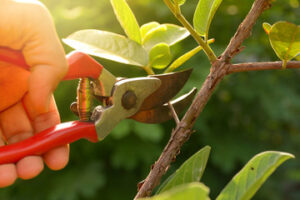Tree pruning is a necessary process for maintaining the health and safety of your trees. It consists of removing dead and extraneous branches and roots from the tree. This procedure will reduce the risk of serious weather damage to trees. In addition, it will improve the look and feel of your landscape. Proper timing of trimming depends on the plant species and the season. Here are some tips for proper tree pruning.

Regardless of the purpose, regular pruning will minimize the risk of storm damage, protect you from falling branches, and reduce the habitat for pests and snakes. In addition, trees should be pruned regularly to maintain a healthy, beautiful appearance. Common techniques include thinning and topping. In thinning, branches are removed from their point of origin, which helps manage growth and improve light penetration. Heading cuts are a more intensive pruning method and are often used to train young trees.
During tree pruning, make sure to cut a branch at a 45-degree angle, so it doesn’t seal off the cut, which could encourage disease. Also, avoid using the stub cut or flush cut. The goal of these methods is to minimize the number of pruned branches and increase the amount of time needed to complete the task. In addition, cutting at an angle of 45 degrees will promote a faster callus formation. If you don’t know how to do this, you can read this article to learn more about pruning trees.
There are various types of tree pruning. Crown thinning is one of them. This technique involves selectively removing branches from the crown of the tree. The aim is to increase light penetration and air movement. Another technique, crown raising, involves cutting the branch off at the bottom of its collar. This method allows for a clear stem for the production of timber. This method is best used when the tree is in a place where it cannot easily grow.
The stub cut is a good option for tree pruning. It doesn’t allow the tree to seal over the cut, and will not allow it to develop the disease. It also prevents the tree from cloning itself. The topmost branch will be the only one pruned with this method. It will be a good choice if you have a lot of space to spare. A stub cut is the best choice for pruning a tree with many stubs.
One of the most common mistakes made by do-it-yourselves is cutting large branches. This practice can cause a tree to fall and be weakened. This can result in a fatality or serious injury. Therefore, it’s best to hire a professional to do it for you. A skilled arborist will be able to help you avoid these mistakes. In the end, you’ll have a beautiful, healthy tree.
Tree pruning involves several different techniques. Using a tripod orchard ladder can be very unstable when using pruning tools. The risk of falling with sharp tools is real. Similarly, climbing into branches is not advisable. Moreover, the risk of falling is high, so it’s best to avoid this method. A tripod orchard ladder is a better option than a ladder when it comes to pruning. Unless you’re comfortable with heights and unstable structures, you should avoid climbing the tree’s canopy.
You should avoid cutting off more than 5% to 20 percent of a tree’s crown during pruning. Leaving a large portion of the tree’s crown in the same location will reduce the tree’s ability to produce new branches. Moreover, a large amount of pruning will result in a decline in the health of the trees. If you’re planning on pruning a tree, it’s a good idea to consult a professional.
Depending on the tree species, the right type of cut will determine the health and longevity of your trees. In addition to that, a stub cut is the easiest to make and won’t cause any damage to the tree. If you’re pruning a branch, you should consider a stub cut. It’s the most common method for trimming, and it should not be used frequently. When pruning a tree, make sure you don’t do anything that could lead to a broken branch.